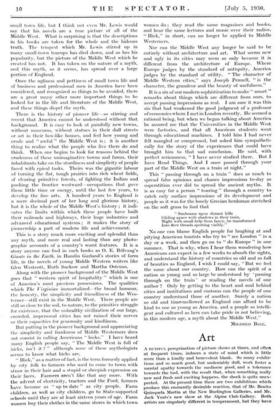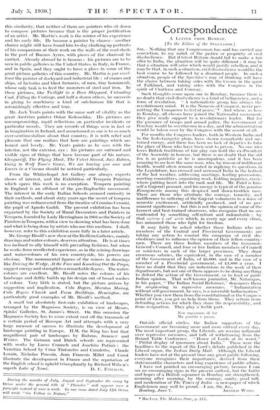Art
A DUTIFUL peregrination of picture shows at times, and often at frequent times, induces a state of mind which is little more than a kindly and benevolent blank. So many exhibi- tions and so much good, but undeniably dull, work foster a mental apathy towards the mediocre good, and a tolerance towards the bad, with the result that, when something really new and fresh and exciting happens, the shock is quite unex- pected. At the present time there are two exhibitions which produce this eminently desirable reaction, that of Mr. Benito Quinquela Martin at the New Burlington Galleries, and Mr. Jack Yeats's new show at the Alpine Club Gallery. Both artists arc singularly different in temperament, but they have this similarity, that neither of them are painters who sit down to compose pictures because that is the proper justification of an artist. Mr. Martin's work is the mirror of his experience and his early life. He became a painter by chance— another chance might still have found him to-day chalking up portraits of his companions at their work on the walls of the coal-sheds in the port of Buenos Ayres, with pieces of the charcoal he carried. Already abroad he is famous : his pictures are to be seen in public galleries in the United States, in Italy, in France, and in Spain, and they ought to have a place in some of the great picture galleries of this country. Mr. Martin is par excel- knee the painter of dockyard and industrial life : of cranes and ships, of factories and blast furnaces, of men, tiny homunculi, whose only task is to feed the monsters of steel and iron. In these pictures, like Twilight in a Boca Shipyard, Unloading Coal, Filling the Castings, and half a dozen others, he succeeds in giving to machinery a kind of sub-human life that is astonishingly effective and true.
Mr. Jack Yeats paints with the same sort of vitality as the great Austrian painter Oskar Kokoschka. His pictures are uncompromising, rapid reflections on particular incidents or particular moods. They are records of things seen in fact or in imagination in Ireland, and accustomed as one is to so much over-sentimentalism about that country, it is with relief and pleasure that one realizes that here are paintings which are honest and lovely. Mr. Yeats paints as he secs with the interior, not the exterior, eye : his pictures are outward and visible signs of things that have become part of his nature. Glengarriff, The Flying Mask, The Velvet Strand, Jazz Babies, Going to Wolf Tone's Grave, We are leaving you now and Lovers in a Cinema should be noticed particularly.
From the Whitechapel Art Gallery one always expects shows of interest, and the Exhibition of Tempera Painting which opens this week is no exception. Tempera painting in England is an offshoot of the pre-Raphaelite movement. The interest in the early Italian Schools aroused curiosity in their methods, and about sixty years ago the secret of tempera painting was rediscovered from the treatise of Cennino Cennini, the pupil of Agnolo Gaddi. The present exhibition has been organized by the Society of Mural Decorators and Painters in Tempera, founded by Lady Herringham in 1901 as the Society of Painters in Tempera, with a view to showing what has been done and what is being done by artists who use this medium. I shall, however, refer to this exhibition more fully in a later article.
Mr. George Bissill's new show at the Redfern Galleries, mainly drawings and water-colours, deserves attention. He is at times too inclined to ally himself with prevailing fashions, but when he works from recollected experience, as in the mining drawings and water-colours of his own countryside, his powers are obvious. The monumental figures of the miners in drawings like Driving the Wedge, At the Face and Knocking Out the Props, suggest energy and strength to a remarkable degree. The water- colours are excellent. Mr. Bissill notes the colours of his landscape and deftly builds up his design out of broad washes of colour. Very little is stated, but the picture arrives by suggestion and implication. Coln Rogers, Marston Maisey, Coln Rogers Church and Farm Buildings, Ifemiaglon, arc particularly good examples of Mr. Ilissilrs method.
A small but absolutely first-rate exhibition of landscapes, arranged by the Magnasco -Society, is on view at Messrs. Spinks' Galleries, St. James's Street. On this occasion the Magnasco Society has to some extent cast off the trammels of a certain period of Baroque Art and attempts with a very large measure of success to illustrate the development of landscape painting in Europe. II 1I. the King has lent that magnificent pair of landscapes by Rubens, Sumner and Winter. The German and Dutch schools are represented with works by Lucas Cranach and Joachim Patinir : the Venetian School by Cima Tintoretto and Canaletto. ('laude Lorain, Nicholas Poussin, Jean Francois Millet and Corot illustrate the development in France and the reputation of the English school is upheld triumphantly by Richard Wilson's











































 Previous page
Previous page